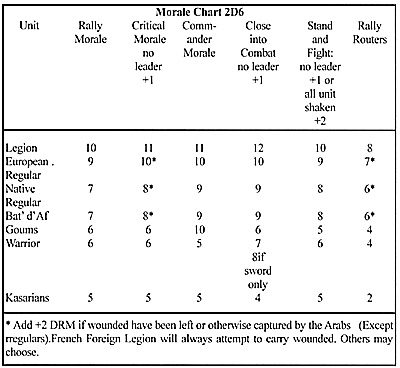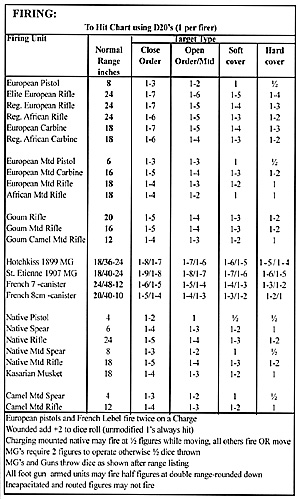A Wargamer’s complete guide to the Armed Opposition to France’s Expansion Across the Algerian-Morrocan Frontier at the Turn of the Century
This section has been approached with the thoughts of The Sword and the Flame firmly in mind. This is an excellent set of colonial wargames rules. It introduced what in their day, were many radically new concepts to gaming: variable unpredictable movement rates and random order of movement among others. It is now happily in print again. Although the following suggested “unofficial” modifications are given for TSATF, their concepts can be adapted to any set of suitable colonial wargame rules. The small scale of many of the actions describe here are played with figure ratios of between 1:1 and 1:10. One of the very convenient attributes of TSATF, is that its mechanics are insignificantly affected by differing figure scales.
One of the main factors that need to be adjusted for this period is the “casualty rates”. As are most “Colonial Rules”, TSATF were written with British colonialism in mind. The casualty rates suffered by the French pale in comparison to those experienced by the British and their armies in Africa and Asia. Timimoun was considered a deplorable loss, with nine dead and some 21 wounded. The El Moungar defeat was an unmitigated disaster that sent reverberations through parliament. It rocked the French government as much as did Britain’s and Italy’s worse African defeats despite the fact that only 36 men died, many of whom were not even French, but Foreign Legionnaires. What we needed to do then is reduce the casualty rates but still make the game exciting. We do this by making the man more valuable than he is often perceived to be in war games. We introduce the wounded man and incapacitated man system that introduces liability of actions and forces caution.
We next expand the morale chart, using a 2D6 method gives a greater range to cover new troop types as introduced here. We also provide a new unique shooting chart for this arena. The rest of the rules stay the same. We do use the common house rule of allowing any unit to move-or-shoot with the turn of his card rather that the original, all-move then all-fire sequence. To complete the necessary casualty reduction process, it is necessary to make a personalized “To-Hit” pack, rather than use the playing card system of the original rules. One card from this pack is drawn each time a “hit” is rolled on the Firing Table.
| Pack Make Up (76 Cards Total) | |||
|---|---|---|---|
| Figure Type | Killed | Incapacitated | Wounded |
| Leader | 1 | 1 | 1 |
| Key Figure | 3 | 3 | 3 |
| Other Figure | 8 | 8 | 10 |
| Missed | |||
The resulting system produces a casualty rate of between 10:1 to 25:1 in favor of the French. Of course, the natives usually considerably outnumber the French to compensate for this. It is not necessary to field all of the natives on the table, but rather to “regenerate” units from the casualty pile. This also simulates the native inability to co-ordinate all of its forces into simultaneous attacks.
The following morale chart replaces the existing morale table. Test morale from the chart under the following circumstances.
Morale
A unit may be required to take more than one morale roll in a turn. These conditions merit a Morale Chart roll. Roll immediately situation arises.
A. Rally Morale. If a unit contains shaken figures, they must rally on this chart. If fail, whole unit may not move but may fire. If pass, shaken figures are brought up to unit, and unit may move as normal. Test when unit’s card is drawn.
B. Leader Morale. Last unit leader is killed/captured. If fail become shaken, retreat 4D6. If native army commander killed, must test each turn, if fail no move that turn. May fire and defend. Test immediately situation occurs.
C. Critical Morale. Units reach 50% dead and incapacitated or entirely shaken units that “take any hits”. If fail, rout 4D6 to table edge. If pass, shaken figures are rallied. (Does not apply to crews in possession of crewed weapon). This test is taken immediately the situation arises, even if unit made a prior test.
Morale Chart

D. Rally Routers. Routers may attempt to rally. Must have a leader. If fail, rout 4D6. Test when unit’s card is drawn.
NOTE: Legion and Bat d’Af in square or any French regular unit in fort, will not retreat.
Wounded and Incapacitated
Wounded men move at normal speed, but may not charge. They will not close in combat and will always run from it if possible. Incapacitated men must be carried by one man (at minus highest movement dice) or by two men (at lowest movement dice). French regulars must carry wounded or suffer the penalty as noted on the morale chart.
Close Combat
Same as main rules for the French Foreign Legion chart except that Kasarians are -1 on the roll. Combat results are as follows
- Loose with 1 (1-2) Dead
Loose with a 2 (3) Runs, wounded.
Loose with a 3 - 6 (4 - 6) Runs
Numbers in parenthesis are for vicious combat. Goums and Sahariennes use vicious combat, as do French and Warriors when the French are surrounded.
Firing Chart

Available Figures
We game exclusively with 28 mm figures of which almost every figure described in this article can be found. The only figure we have been unable to supply is a suitable looking Spahis figure. This list is not meant to be exhaustive. There are a number of other scales available. Redoubt make a French Foreign Legion range in 30 mm. B&B figures do so for 20 mm and in true 25 mm scale Frontier make a range also.
The following manufacturers provide the bulk of our figures.
Old Glory
- Sons of the Desert range French Foreign Legion (many poses) used also for Bat d’Af
Goums, also mounted
Warriors with rifles, swords and spear
Sahariennes (not all of the OG figures have rifles, the spears can be easily removed and replace with a rifle)
Mounted warriors with sword or rifle (we use these for Spahis too.)
Chasseurs d’Afrique
The 8cm gun from the Spanish American War range can be easily converted to look like a breach loader.
Foundry Franco Prussian War range
- Zouaves, various poses, also use for Tirailleurs
Chasseur d’Afrique, mounted and dismounted.
Pack mules and camels.
Foundry Darkest Africa
- Mix Zanzibari Arabs with flintlock muskets with warriors from the Old Glory lines for Kasarians,. Some of the figures have Negroid features and make good Haratin.
Civilian figures for characters such as Flamand.
Askar figures make good baggage handlers for the pack mules and camels
Reviresco
- A selection of Arabic beggars and thieves make good civilians for the Kasars and oases and also a French 75mm artillery piece.
The Scenarios
The following scenarios are based on the battles described earlier in the article. The set up information and order of battle is given as a guide. It can be modified to some extent depending on figure availability.
After the occupation of the Tuat, Tidikelt and Gourara, the resistance resorted to series of supply train raids. These types of games can be played very easily with small numbers of figures.
Victory Conditions
The victory condition for each scenario is based around maintaining French credibility. Each victory condition can be taken as an individual result or they can be tied together for a campaign.
The advantage of this system is that it gives the Arabs and Berbers an opportunity to win the games, without actually winning the battles, which is very hard for them to do. Although they will almost always loose in a stand up fight (in terms of casualties lost compared to casualties inflicted), they can win by making the French victory so costly for them that they are forced by their government to withdraw.
In an individual game, French credibility starts at 100%. If they are able to finish the game at 75% credibility or greater, they are victorious. If they finish the game at 50% - 74% they have a marginal victory. If they finish the game below 50% they loose and the natives are victorious. In a campaign game, if the objective of the scenario is achieved, the French add 25% credibility to their end credibility result and proceed to the next scenario. If they loose, they may have to re-fight the same scenario again. The credibility result is carried over from game to game. French losses to credibility must be made up for by successive victories. French credibility may not rise above 125%.
A campaign example. The French achieve the objective of the first scenario. It costs them 23% credibility in doing so. However, because they achieved the objective, they add 25% and start the next scenario with 102%.
In the second scenario they don’t achieve their objective and the battle costs them 34% in credibility. They must now fight that battle again, as per the re-fight instructions, but start with 68% credibility. They again fail to achieve the objective and expend a further 22% credibility. They re-fight again as per the re-fight instructions, this time starting with 46% credibility. They finally achieve their objective, with a further loss of 7% leaving them with 39%. However, as they have succeeded, they add 25% credibility and move to the next scenario with 64% credibility.
This method will quickly produce some interesting strategic considerations, particularly for the Natives, which I will leave you to discover.
Note
The Sword and The Flame rules are required to play these scenarios as written. TSATF are copyright,Larry Brom and are available for $25 from “And that’s the Way It Was” www.thewayitwas.com or 213 3rd St. NE, Hickory NC 28601-5124
Resistance in the Desert: Part II by Ian Croxall
-
Rule Modifications for TSATF
Scenario 1: Battle of Ingotsen
Scenario 2: Battle of In Salah
Scenario 3: Assault of Rhar
Scenario 4: Repulse from Metarfa
Scenario 5: Counterattack at Timimoun
Scenario 6: Retreat to Charouine
Back to Table of Contents -- Courier #81
To Courier List of Issues
To MagWeb Master Magazine List
© Copyright 2001 by The Courier Publishing Company.
This article appears in MagWeb (Magazine Web) on the Internet World Wide Web.
Other military history articles and gaming articles are available at http://www.magweb.com